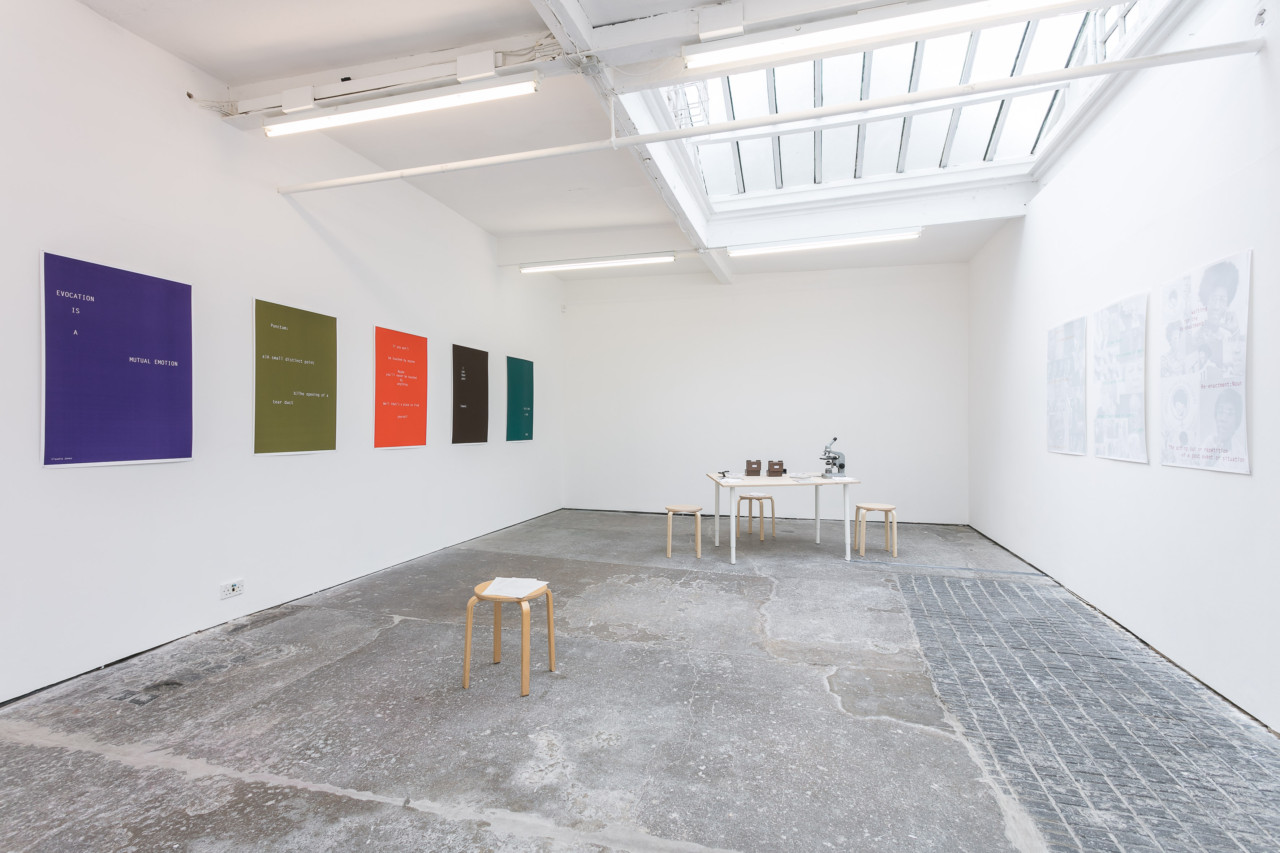


Helen Cammock Shouting in Whispers installation view, Cubitt Gallery, 2017. Photography by Mark Blower, courtesy of Cubitt Artists.
"Thinking about Who represents Whom and for Whom" is described by Helen Cammock as key to her artistic practise. Born to an English mother and a Jamaican father in 1970, she worked as a social worker before becoming an artist. Her research-led approach to making art remains sensitive to the oppressions, misrepresentation and inequalities that she witnessed across different communities during her employment in social care. Cammock works in a range of mediums including video, photography, installation, print and performances, intersecting her own texts with quotes from writers, poets and activists. She is interested in text and the role of language, her poetic multi-media installations highlight aspects of the past that have been suppressed in favour of the dominant histories we read, tell and teach today.
When entering the exhibition space at Cubitt Gallery, to Cammock’s first solo show in a UK institution, I am drawn towards the print series Shouting in Whispers that consists of five monochrome prints. Their rich and sumptuous colours – red, brown, green, blue and moss-green – are hand-mixed by the artist. The text on the posters combine text fragments from different sources, for example ‘This is not a love song’ is a familiar track by Public Enemy, ‘Evocation is a mutual emotion’ comes from Trinidad born activist and journalist Claudia Jones (1915-1964).
Three pale grey prints on the opposite wall titled Slide Re-enactmentfunction as an abstract visual essay. Here Cammock has created photographic collages from found online images. The first poster displays Barak Obama, the second Theresa May and Boris Johnson, the third Shirley Chisholm, who was both the first Black American and the first woman to run for the Democratic Party’s presidential nomination in the US in 1972. The prints are juxtaposed with texts fragments from a dictionary, for example ‘Landslide: A sudden movement of a large mass of mud or rock down a hill’ is written on the print that shows Barack Obama.
Slide Re-enactment – a proposition displays Cammock’s own collection of stamps on a table in the exhibition space. The visitor is invited to look at the stamps through a microscopic glass, each relating to past and present global political and cultural events. Gathered in several archive boxes, they are presented as both as solo images and in pairs. We find stamps from the Central African Republic to commemorate Brexit, featuring Nigel Farage, Theresa May and Boris Johnson, others show lesser known figures such as the Black American novelist Paul Laurence Dunbar (1872-1906), who is paired with Stevie Wonder. A stamp that depicts John Wayne is juxtaposed with a ‘Stop Family Violence’ stamp bringing to mind male violence and the role of machismo in American culture.
An hour-long film shows past and contemporary moments of resistance, violence and manipulation. The film utilises self-shot footage combined with selected and edited YouTube clips. These include an ambush of young soldiers in Vietnam in the late 1960, a present day female Yazidi fighter training camp, scenes from the Brixton Riots in 1981, Russian tanks invading Czechoslovakia in the 1968 and recent footage from Palestine where a young woman defends a crowd of protesters. The film ends with Cammock viewing a speech by Shirley Chisholm, on a backdrop of Malian cloth commemorating Barak Obama. This powerful ending makes me wonder which course history would have taken, if an African-American woman had been elected as President of the United States in the early 1970s.
Performance and the voice play a key role in Cammock’s practise. A series of performances will punctuate the exhibition’s beginning, middle and end. The first took place at the opening of the show and was performed by the artist herself. Equally strong and vulnerable, singing unaccompanied into the gallery space, the performance was based on her own personal writings interspersed with old Caribbean folk songs, a poem by Langston Hughes and writings by Franz Fanon. I highly recommend visiting Shouting in Whispers when one of Cammock’s performances is taking place. Witnessing the artist singing, speaking and reading poetry forms a lively and powerful compliment to the conceptual and minimalist layout of the exhibition.
Overall, the exhibition encourages us to slow down, to really look and to make our own connections between the different elements of her work and their engagement with national and global politics. Cammock challenges us to reflect on how we commemorate and represent historical moments and people and to think about who is rendered invisible or unacknowledged by history and present culture. This timely process of reflecting heightened by senses and made me reflect on my own position within the political and social spaces we inhabit.
Helen Cammock gained her MA in Photography from the RCA in 2011. She had an exhibition and commission with Bookworks as part of Hull City of Culture, 2017 and has been included in the Serpentine Cinema series, Tate Artist Moving Image Series and Open Source 2016.
Christine Takengny
Curator
Cubitt Gallery, 8 Angel Mews, London N1 9HH. Open Wednesday - Sunday 12.00 – 18.00. Exhibition continues until Sunday 12 November 2017. www.cubittartists.org.uk